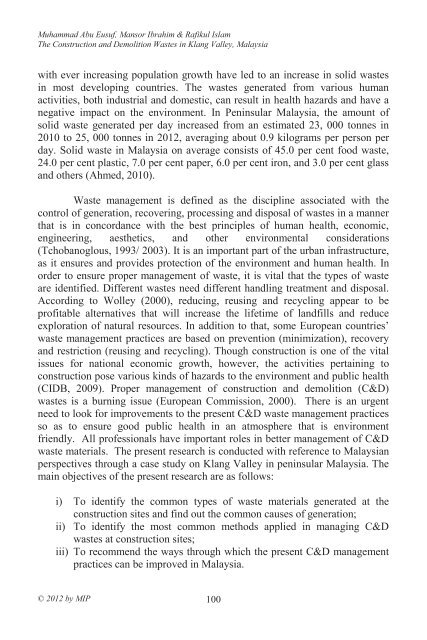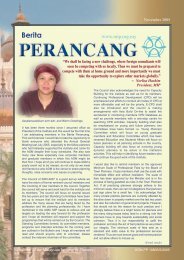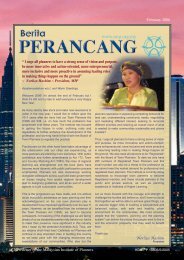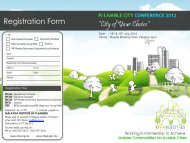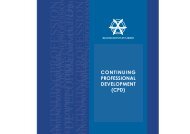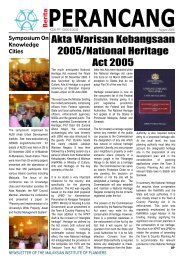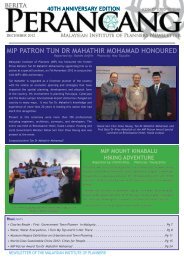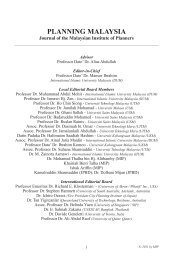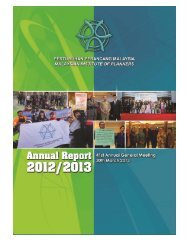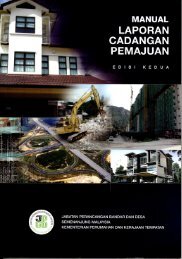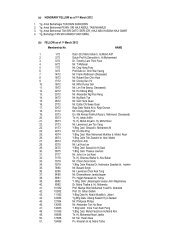Untitled - Malaysian Institute of Planners
Untitled - Malaysian Institute of Planners
Untitled - Malaysian Institute of Planners
You also want an ePaper? Increase the reach of your titles
YUMPU automatically turns print PDFs into web optimized ePapers that Google loves.
Muhammad Abu Eusuf, Mansor Ibrahim & Rafikul IslamThe Construction and Demolition Wastes in Klang Valley, Malaysiawith ever increasing population growth have led to an increase in solid wastesin most developing countries. The wastes generated from various humanactivities, both industrial and domestic, can result in health hazards and have anegative impact on the environment. In Peninsular Malaysia, the amount <strong>of</strong>solid waste generated per day increased from an estimated 23, 000 tonnes in2010 to 25, 000 tonnes in 2012, averaging about 0.9 kilograms per person perday. Solid waste in Malaysia on average consists <strong>of</strong> 45.0 per cent food waste,24.0 per cent plastic, 7.0 per cent paper, 6.0 per cent iron, and 3.0 per cent glassand others (Ahmed, 2010).Waste management is defined as the discipline associated with thecontrol <strong>of</strong> generation, recovering, processing and disposal <strong>of</strong> wastes in a mannerthat is in concordance with the best principles <strong>of</strong> human health, economic,engineering, aesthetics, and other environmental considerations(Tchobanoglous, 1993/ 2003). It is an important part <strong>of</strong> the urban infrastructure,as it ensures and provides protection <strong>of</strong> the environment and human health. Inorder to ensure proper management <strong>of</strong> waste, it is vital that the types <strong>of</strong> wasteare identified. Different wastes need different handling treatment and disposal.According to Wolley (2000), reducing, reusing and recycling appear to bepr<strong>of</strong>itable alternatives that will increase the lifetime <strong>of</strong> landfills and reduceexploration <strong>of</strong> natural resources. In addition to that, some European countries’waste management practices are based on prevention (minimization), recoveryand restriction (reusing and recycling). Though construction is one <strong>of</strong> the vitalissues for national economic growth, however, the activities pertaining toconstruction pose various kinds <strong>of</strong> hazards to the environment and public health(CIDB, 2009). Proper management <strong>of</strong> construction and demolition (C&D)wastes is a burning issue (European Commission, 2000). There is an urgentneed to look for improvements to the present C&D waste management practicesso as to ensure good public health in an atmosphere that is environmentfriendly. All pr<strong>of</strong>essionals have important roles in better management <strong>of</strong> C&Dwaste materials. The present research is conducted with reference to <strong>Malaysian</strong>perspectives through a case study on Klang Valley in peninsular Malaysia. Themain objectives <strong>of</strong> the present research are as follows:i) To identify the common types <strong>of</strong> waste materials generated at theconstruction sites and find out the common causes <strong>of</strong> generation;ii) To identify the most common methods applied in managing C&Dwastes at construction sites;iii) To recommend the ways through which the present C&D managementpractices can be improved in Malaysia.© 2012 by MIP


